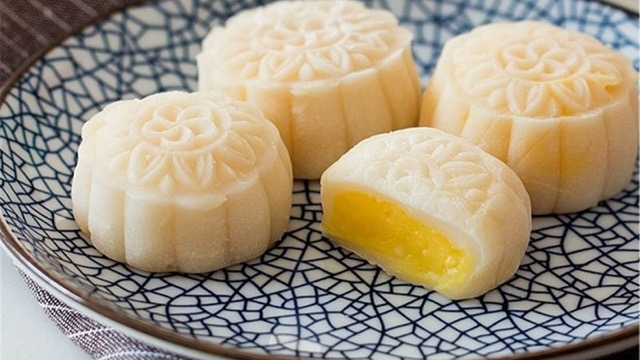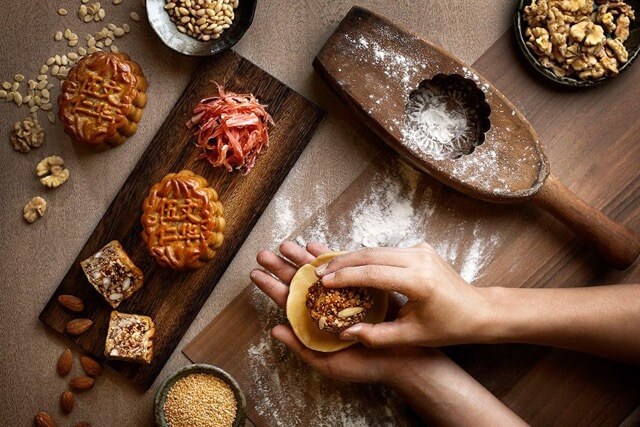Mooncake Vietnam holds a special place in the country’s cultural and culinary traditions. Celebrated during the Mid-Autumn Festival, these delectable treats bear significant historical and cultural meaning. Dedicated to the moon goddess, mooncakes have a long-standing presence in Vietnamese culture.
Traditional mooncakes in Vietnam have a centuries-long history and are often filled with lotus seed paste and a salted egg yolk to signify the full moon. Modern modifications to the basic recipe, however, have evolved in recent years, with new flavors and shapes becoming increasingly popular.
In this blog article, we’ll go deeper into Vietnamese mooncakes, examining both traditional and modern variations and uncovering the distinct flavors and textures that make them such a popular treat.
See more: Embracing the Cuisine of Vietnam – An Exciting Culinary Journey
Mooncake Vietnam: Exploring Types, History, and Where to Find Traditional Mooncakes
Traditional mooncakes in Vietnam come in various types, but two of the most common are bánh nướng and bánh dẻo.
Bánh nướng, also known as baked mooncakes, are made with a soft, flaky pastry shell and filled with lotus seed paste, which is mildly sweet and fragrant. A single salted duck egg yolk is often placed in the center, symbolizing the full moon.
The pastry shell is usually made with wheat flour, sugar, and oil, filling using dried lotus seeds, sugar, and oil. Bánh nướng is a traditional form of mooncake that has been relished in Vietnam for decades, and it is still a favorite option during the Mid-Autumn Festival.


In Vietnam, both bánh nướng and bánh dẻo have a long history and cultural significance. During the Mid-Autumn Festival, they are customarily given as gifts to family and friends as a symbol of appreciation and unity. Mooncakes’ circular shape denotes completion and reunion, while the ingredients used have symbolic meanings and are thought to bring good luck and wealth.
Many bakeries and businesses in Vietnam specialize in traditional mooncakes if you’re looking for the best. Tan Dinh Market, Bánh Kẹp Trứng, and Bánh Kẹp Nướng are three popular destinations to visit in Ho Chi Minh City. During the Mid-Autumn Festival, you can visit Hang Than Street in Hanoi, where several bakeries serve bánh nướng and bánh dẻo.
Mooncakes are typically only available for purchase around the Mid-Autumn Festival season, which falls on the 15th day of the 8th lunar month, usually in September or early October. The availability of mooncakes varies, but they are usually sold starting a few weeks before the festival and continue to be available for a few weeks after. It’s important to note that mooncakes are a seasonal treat in Vietnam, so if you want to try them, it’s best to plan accordingly during the festival season.
Discovering more authentic dishes of Vietnam cuisine to have a perfect culinary adventure.
Discovering the New Flavors and Trends of Modern Mooncakes in Vietnam
Modern mooncakes have become increasingly popular in Vietnam, with new flavors, designs, and ingredients being introduced in recent years. Ice cream mooncakes and snow skin mooncakes are two of the most popular modern varieties, and they can be found in large ice cream shops or chocolate stores during the Mid-Autumn Festival season.
Ice cream mooncakes typically feature a soft, creamy ice cream filling flavored with lotus seed paste, green tea, or chocolate, and may also contain fruit or nuts. The outer layer can be made of cake, chocolate, jelly, or other materials, offering a unique twist on traditional mooncakes.

Another famous variety of modern mooncakes is snow skin mooncakes, which have a soft and chewy outer layer that replicates the texture of snow. The filling can be sweet or savory, and several new varieties, such as durian, matcha, and mango, have appeared in recent years.
In Vietnam, the ingredients and flavors of modern mooncakes vary considerably, reflecting the inventiveness and innovation of local and pastry chefs. Some modern mooncakes have unusual components such as cheese, bacon, or truffles, while others offer exotic fruits and flavors.
If you want to try modern mooncakes in Vietnam, there are many bakeries and businesses that specialize in them. Maison Marou is a popular choice with branches in both Ho Chi Minh City and Hanoi, offering a fantastic assortment of chocolate mooncakes.
Overall, modern mooncakes in Vietnam are a terrific opportunity to try traditional mooncake flavors in new and intriguing ways, and they are likely to please both locals and visitors.
Don’t Forget to Try Vietnamese Dimsum in Your Culinary Journey.
Traditions and Celebrations of Mooncakes in Vietnamese Culture
Mooncakes play a significant role in Vietnamese culture, especially during the Mid-Autumn Festival. This festival is a time for family gatherings, giving thanks, and honoring the moon goddess; mooncakes are an essential part of the celebrations.

Mooncakes are commonly presented as gifts to family members, friends, and business acquaintances in Vietnam as a symbol of gratitude and unity. They are also utilized in numerous ceremonies and traditions, such as giving mooncakes to the moon goddess and exchanging mooncakes between family members and friends.
Making mooncakes is a time-consuming technique that involves multiple processes. The pastry shell comprises wheat flour, sugar, oil, and water and is rolled out before being filled with a variety of sweet or savory fillings such as lotus seed paste, red bean paste, mung bean paste, or mixed nuts. To represent the full moon, the filling is frequently formed into a ball and placed in the center of the pastry, and a salted duck egg yolk is added.

Mooncakes are shared with family and friends while admiring the splendor of the full moon during the Mid-Autumn Festival. Mooncakes are traditionally sliced into slices and shared among family and friends, along with glasses of hot tea. People in various parts of Vietnam organize lantern parades and dragon dances during the festivities.
Finally, mooncakes have a particular position in Vietnamese culture, and their significance during the Mid-Autumn Festival extends beyond their delectable taste. They represent unity, appreciation, and tradition; their practices and traditions are profoundly embedded in Vietnamese culture.
Vietnamese cuisine boasts a rich tapestry of flavors and dishes, but few are as emblematic as Bánh Mì, the beloved Vietnamese bread.
Conclusion
Mooncakes are often given as gifts to family and friends as a symbol of gratitude and unity, and they are also used in various customs and traditions. The round shape of mooncakes represents completeness and reunion, while the ingredients used have symbolic meanings and are believed to bring good luck and prosperity.
To sum up, mooncakes have a special place in Vietnamese culture and traditions, and people of all ages enjoy them during the Mid-Autumn Festival. From classic flavors to modern twists, there is a mooncake for every taste and preference.



Related Posts
Vietnam Motorbike Adventures: The Ultimate Guide
With its breathtaking landscapes, rich cultural heritage, and vibrant local experiences, Vietnam offers an unforgettable adventure for motorbike enthusiasts. Discover hidden gems, meet friendly locals, and create lasting memories as you explore diverse terrains and immerse yourself in the heart of Vietnam. Why Choose a Motorbike Adventure in Vietnam? Freedom and Flexibility If you love […]
Experience the Living Conditions in Cu Chi Tunnels: Unbelievable!
Cu Chi Tunnels served as the living quarters for soldiers and civilians during Vietnam’s resistance against France and America. Today, this remarkable site stands as a symbol of perseverance, determination, and resilience during one of the most challenging periods in Vietnamese history. Discover the living conditions in Cu Chi Tunnels with Joy Journeys in the […]
Vietnam Fish Cake: A Culinary Delight
Vietnam fish cake, known for its delicious and diverse flavors, is a favorite among tourists looking to explore authentic Vietnamese cuisine. From the crispy, golden-brown texture of fried fish cakes to the fragrant, herb-infused variations found in regional specialties, these savory delights offer a true taste of Vietnam. In this article, we will take you […]